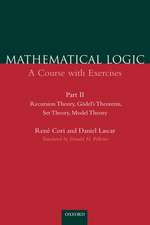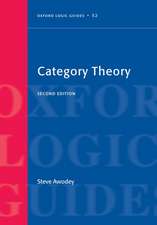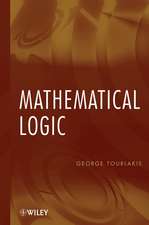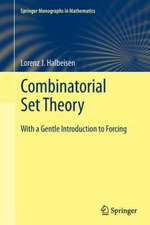Course of Mathematical Logic: Volume 2 Model Theory: Synthese Library, cartea 69
Autor R. Fraïssé Traducere de David Louvishen Limba Engleză Hardback – 31 oct 1974
| Toate formatele și edițiile | Preț | Express |
|---|---|---|
| Paperback (1) | 383.71 lei 6-8 săpt. | |
| SPRINGER NETHERLANDS – 31 oct 1974 | 383.71 lei 6-8 săpt. | |
| Hardback (2) | 389.70 lei 6-8 săpt. | |
| SPRINGER NETHERLANDS – 31 oct 1974 | 389.70 lei 6-8 săpt. | |
| SPRINGER NETHERLANDS – 29 noi 1973 | 785.61 lei 38-45 zile |
Din seria Synthese Library
- 15%
 Preț: 638.43 lei
Preț: 638.43 lei - 18%
 Preț: 989.98 lei
Preț: 989.98 lei - 15%
 Preț: 596.69 lei
Preț: 596.69 lei - 18%
 Preț: 903.93 lei
Preț: 903.93 lei - 15%
 Preț: 586.88 lei
Preț: 586.88 lei - 15%
 Preț: 696.50 lei
Preț: 696.50 lei - 18%
 Preț: 892.90 lei
Preț: 892.90 lei - 15%
 Preț: 643.34 lei
Preț: 643.34 lei -
 Preț: 282.33 lei
Preț: 282.33 lei - 5%
 Preț: 372.19 lei
Preț: 372.19 lei -
 Preț: 443.10 lei
Preț: 443.10 lei - 15%
 Preț: 637.59 lei
Preț: 637.59 lei - 18%
 Preț: 958.88 lei
Preț: 958.88 lei - 15%
 Preț: 642.36 lei
Preț: 642.36 lei - 18%
 Preț: 1230.66 lei
Preț: 1230.66 lei - 15%
 Preț: 642.83 lei
Preț: 642.83 lei - 18%
 Preț: 1000.39 lei
Preț: 1000.39 lei -
 Preț: 389.70 lei
Preț: 389.70 lei - 15%
 Preț: 637.28 lei
Preț: 637.28 lei - 18%
 Preț: 952.26 lei
Preț: 952.26 lei - 18%
 Preț: 1231.32 lei
Preț: 1231.32 lei - 15%
 Preț: 645.96 lei
Preț: 645.96 lei -
 Preț: 395.85 lei
Preț: 395.85 lei -
 Preț: 400.47 lei
Preț: 400.47 lei - 18%
 Preț: 1225.48 lei
Preț: 1225.48 lei - 15%
 Preț: 638.89 lei
Preț: 638.89 lei - 18%
 Preț: 1232.09 lei
Preț: 1232.09 lei -
 Preț: 380.45 lei
Preț: 380.45 lei -
 Preț: 394.87 lei
Preț: 394.87 lei - 15%
 Preț: 640.37 lei
Preț: 640.37 lei - 15%
 Preț: 639.08 lei
Preț: 639.08 lei -
 Preț: 381.98 lei
Preț: 381.98 lei - 15%
 Preț: 643.00 lei
Preț: 643.00 lei - 15%
 Preț: 672.29 lei
Preț: 672.29 lei
Preț: 389.70 lei
Nou
Puncte Express: 585
Preț estimativ în valută:
74.57€ • 79.74$ • 62.17£
74.57€ • 79.74$ • 62.17£
Carte tipărită la comandă
Livrare economică 18 aprilie-02 mai
Preluare comenzi: 021 569.72.76
Specificații
ISBN-13: 9789027702692
ISBN-10: 9027702691
Pagini: 222
Ilustrații: XX, 198 p.
Dimensiuni: 155 x 235 x 18 mm
Greutate: 0.45 kg
Ediția:1974
Editura: SPRINGER NETHERLANDS
Colecția Springer
Seria Synthese Library
Locul publicării:Dordrecht, Netherlands
ISBN-10: 9027702691
Pagini: 222
Ilustrații: XX, 198 p.
Dimensiuni: 155 x 235 x 18 mm
Greutate: 0.45 kg
Ediția:1974
Editura: SPRINGER NETHERLANDS
Colecția Springer
Seria Synthese Library
Locul publicării:Dordrecht, Netherlands
Public țintă
ResearchCuprins
1/Local Isomorphism and Logical Formula; Logical Restriction Theorem.- 1.1. (k,p)-Isomorphism.- 1.2. (k,p)-Equivalence.- 1.3. Characteristic of a Logical Formula. Relations Between (k,p) -Isomorphism and Logical Formula.- 1.4. Logical Extension and Logical Restriction; Logical Restriction Theorem.- 1.5. Examples of Finitely-Axiomatizable and Non-Finitely-Axiomatizable Multirelations.- 1.6. (k,p)-Interpretability.- 1.7. Homogeneous and Logically Homogeneous Multirelations.- 1.8. Rigid and Logically Rigid Multirelations.- Exercises.- 2/Logical Convergence; Compactness, Omission and Interpretability Theorems.- 2.1. Logical Convergence.- 2.2. Compactness Theorem.- 2.3. Omission Theorem.- 2.4. Interpretability Theorem.- 2.5. Every Injective Logical Operator is Invertible.- Exercise.- 3/Elimination of Quantifiers.- 3.1. Absolute Eliminant.- 3.2. (k,p)-Eliminant.- 3.3. Elimination Algorithms for the Chain of Rational Numbers and the Chain of Natural Numbers.- 3.4. Positive Dense Sum; Elimination of Quantifiers over the Sum of Rational or Real Numbers.- 3.5. Positive Discrete Divisible Sum; Elimination of Quantifiers over the Sum of Natural Numbers.- 3.6. Real Field; Elimination of Quantifiers over the Sum and Product of Algebraic Numbers or Real Numbers.- Exercises.- 4/Extension Theorems.- 4.1. Restrictive Sequence; (k,p)-Isomorphism and (k,p)-Identimorphism.- 4.2. Application to Logical Restriction.- 4.3. Projection Filter.- 4.4. Logical Extension Theorems.- 4.5. Theorem on Common Logical Extensions.- 4.6. Logical Morphism and Logical Embedding.- Exercises.- 5/Theories and Axiom Systems.- 5.1. Theory: Consistency; Intersection of Theories.- 5.1 Axiom System. Class of Models; Union-Theory, Finitely-Axiomatizable Theory, Saturated Theory.- 5.3. Complement of a Theory.- 5.4. Categoricity.- 5.5. Model-Saturated Theory.- Exercises.- 6/Pseudo-Logical Class; Interpretability of Theories; Expansion of a Theory; Axiomatizability.- 6.1. Pseudo-Logical Class.- 6.2. Interpretability of Theories.- 6.3. Canonical Expansion, Semantic Expansion, and Other Expansions.- 6.4. Axiomatizable Multirelations and Theories.- 6.5. Free Expansion.- Exercises.- 7/Ultraproduct.- 7.1. Family of Multirelations, Ultrafilter, Induced Logical Equivalence Class; Ultraproduct and Ultrapower; Maximal Case.- 7.2. Logical Equivalence Implies the Existence of Isomorphic Ultrapowers.- 7.3. Characterization of Logical Classes.- 7.4. Normal Ultraproduct; Definitions and Examples.- 7.5. Normal Ultraproducts and Logical Equivalence.- Exercises.- 8/Forcing.- 8.1. Generic Predicate; System: (+)-Forced and (?)-Forced Formulas.- 8.2. Elementary Properties.- 8.3. Forcing with Constraints.- 8.4. General Relation.- 8.5. Forcing and Deduction; Theory Forced by a Generic Predicate.- Exercises.- 9/Isomorphisms and Equivalences in Relation to the Calculus of Infinitely Long Formulas with Finite Quantifiers.- 9.1. ?-Isomorphism and ?-Equivalence.- 9.2. ?-Isomorphism and ?-Equivalence; Karpian Families.- 9.3. Automorphic Rank of a Multirelation.- 9.4. Multirelations with Denumerable Bases and ?-Isomorphisms.- 9.5. ?-Extension and ?-Interpretability.- 9.6. Infinite Logical Calculi and their Relation to Local Isomorphisms and Equivalences.- Proof of Lemmas Needed to Prove J. Robinson’s Theorem.- Closure of a Relation.- References.



















